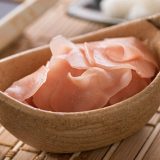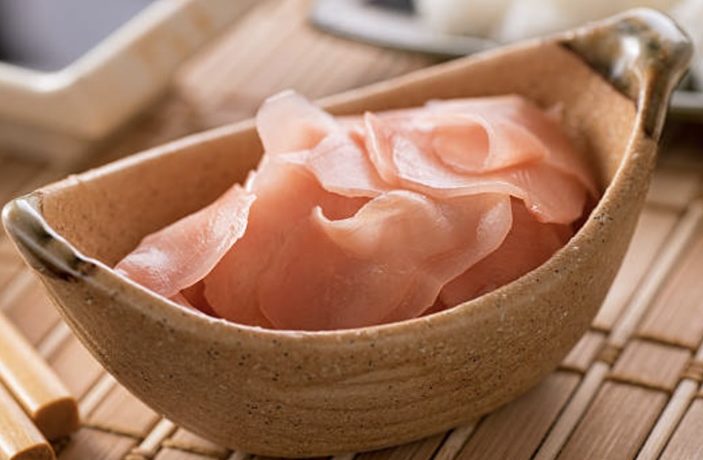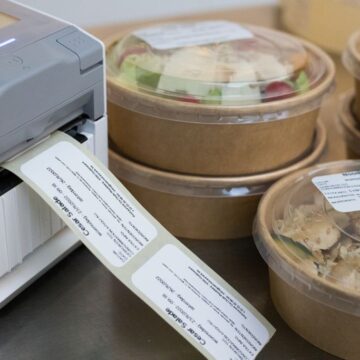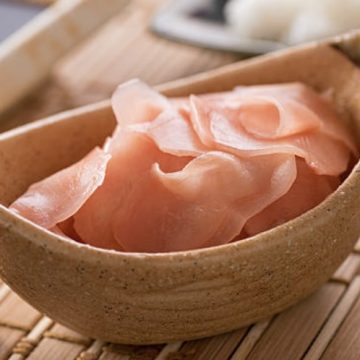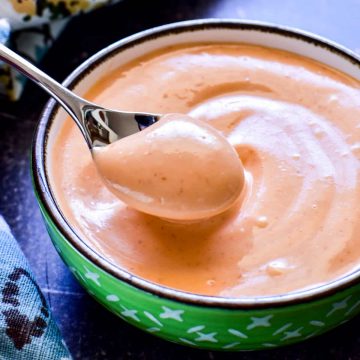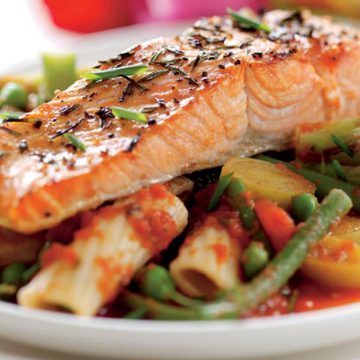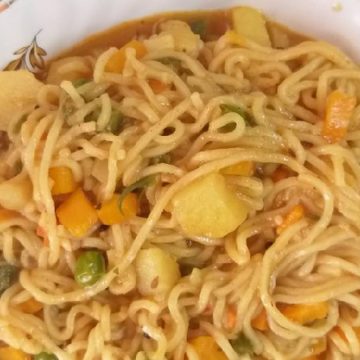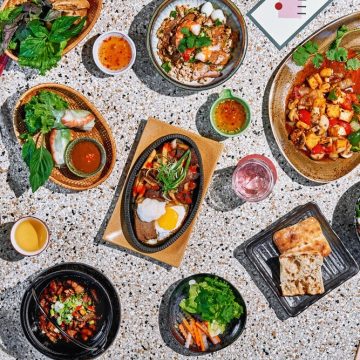Gari of sushi ginger is a popular accompaniment to any sushi platter. Sushi ginger is often used to cleanse the palate. Pickled ginger is well-known for its distinctive pink hue. Some might wonder: What makes sushi ginger pink?
What is Sushi Ginger?
Sushi ginger, pink Ginger, and gari are all staples of sushi. It is a traditional accompaniment that cleanses the palate between different types of sushi. Pickled ginger can also elevate sushi dishes’ seafood.
Gari is easy to prepare. Pickling young ginger thinly with sugar and vinegar is a simple process. Gari is preserved in a jar to be picked.
Sushi ginger can be eaten before, after, or in between sushi. According to Japanese tradition, pickled ginger is believed to preserve the flavor by cleaning out the palate. Pickled ginger is recommended if you are switching between types of sushi.
Pickled ginger is mildly spicy and helps to reduce the strong seafood flavor. Gari’s natural sweet and juicy flavor balances the fishy taste of raw fish.
Why is Sushi ginger pink?
Sushi ginger is pink because of the pink pigment found at the roots. Gari is often harvested in summer, when the gingers are still young. By slicing the ginger and picking it, the pigments are added to the pickle brine.
The brine will absorb the ginger roots’ pigments as the ginger pickles more. Pickling gives sushi ginger its distinctive pink color.
Most sushi ginger that is manufactured is made with E124 or beet pulp. E124 is required to give sushi ginger its pink hue because most factories use mature white ginger. Gari is not available year-round as it is only seasonal.
To get a distinctive pink color, most sushi ginger that isn’t made in Japan needs to be diluted with beet juice. Even though they may be young, some gingers do not have a pink hue. It gives the illusion that you are authentic by adding E124.
Some restaurants do not serve pink sushi ginger. Some restaurants use cream-colored or white gari. The change is usually not noticeable and has little effect on the dining experience.
Over time, the pink hue of authentic sushi ginger may fade. Even if the gari is made from young Japanese ginger, it can turn creamy or off-white. Gari’s texture and taste will not be affected by the color change.
Pickled ginger will become white, yellow and brown once the pink tint from the gari has disappeared. This is why sushi chefs and owners of sushi bars use pink dye to pickle ginger. A brown or discolored ginger is not appealing to most people.
Why is pink ginger used in sushi?
Red ginger (also known as pink ginger) is grown naturally in cooler and less humid environments. Pink ginger is a common crop in Japan’s mountains and farms during the summer. South Florida, America is the largest supplier of pink ginger.
Pink ginger flowers will appear around the middle of summer and early fall. The plant needs to be watered regularly as it is susceptible to drying out. You can grow and harvest pink ginger from your own garden.
Pink ginger is readily available in Asian grocery stores and supermarkets during early summer. It is best to get it early in the summer if you want to try it.
Japanese restaurants and sushi bars love pink ginger for its tender texture and juicy flavor. Pink ginger is milder in flavor and has a subtle sweetness that white ginger lacks. It also has a milder ginger aroma.
Look out for roots when searching for pink ginger. Original pink ginger roots have a subtle tinge of color. When pink ginger is to be used for pickling or gari, only the young ginger can help.
The skin of mature pink ginger becomes more stiff and difficult to chew. The mature ginger’s flavor is also more intense.
When used as a sushi accompaniment, the strong flavors can be overwhelming. It can get in the way of the natural flavors of sushi.
Pickled Ginger is a good choice for sushi.
Pickled ginger is used mainly for palate cleansing. Gari’s anti-microbial properties were its main purpose in ancient times.
Traditional sushi uses raw seafood often as the primary ingredient. Pickled ginger is an accompaniment that reduces the risk of bacterial contamination. Sushi ginger kills the bloodborne parasites from raw fish.
Pickled ginger is used to cleanse the palate, as both the medical and agricultural industries have learned more about the bacteria found in raw seafood. Pickled ginger should be eaten between each batch of sushi.
Pickled ginger not only has anti-microbial and health benefits but also enhances the sushi experience. Pickled ginger is a wonderful accompaniment to seafood, with its mild-ginger taste and sweet aftertaste. It has a milder and more smooth flavor that counters the savory taste of raw seafood.
Is Pickled Ginger Good for You?
Total Fat
0.8 g
Total Carbohydrate
18 g
Dietary fiber
2 g
Sugar
2 g
Protein
1.8 g
Potassium
415 mg
Magnesium
43 mg
Vitamin B-6
0.2%
Vitamin C
5 mg
Iron
0.6 mg
Calcium
16 mg
USDA Nutritional Facts for One Hundred Grams of Sushi Ginger
Sushi ginger is an excellent accompaniment to sushi. Although it is low in calories, it is high in potassium and magnesium. It contains small amounts of vitamins, such as vitamin C or vitamin B6.
The antioxidants in pink ginger can also help boost the immune system. Vinegar brine has antibacterial qualities.
Preservatives are not used in authentic sushi ginger. It is sufficient to pickle the ginger to prevent it from becoming contaminated with bacteria or fungi. Pickled sushi can be stored and eaten as long as it is sealed tightly in the jar.
Sushi is great for many reasons. Gari’s natural anti-microbial qualities help to lower foodborne diseases. This is a significant health benefit, as traditional sushi often contains raw fish.
What’s the difference between pink ginger and white?
Ginger?
Both white and pink ginger are available in Japan, as well as the United States. But what is the difference? Let’s discover which ginger is best for sushi.
Pink Ginger
The most common gari in restaurants is pink ginger. Pink ginger is well-known for its mild ginger flavor, sweet taste, and sweetness. It is also much more tender than white ginger and it’s recommended as a sushi garnish.
White Ginger
White sushi might be a good choice for pickled ginger. It is more affordable than pink ginger and easier to find. Is white ginger good for gari?
As a garnish for sushi, white ginger is not recommended. White ginger is more hardy than pink ginger, which has a soft and delicate texture. White ginger is great for cooking because of its unique properties.
This ginger has a stronger flavor so you only need a small amount to make a batch. White ginger is often found in seafood and fish dishes. Its strong flavor counters the fishy taste of seafood.
Pickled Ginger has many benefits
Pickled ginger has many health benefits that will not only benefit your health, but also enhance your dining experience.
Antimicrobial and Antifungal Properties
Pickled ginger’s antimicrobial properties have been recognized since ancient times. Ginger was used in ancient Japanese cuisine for its antimicrobial properties, before it was used for flavor.
It is a delicious and healthy way to fight the spread of bloodborne diseases from raw seafood. It can also be used as an antioxidant to combat disease.
Colon improvement
Pickled ginger’s antimicrobial properties not only protect your stomach but also your immune system.
https://sushiincorporated.com/ is a vibrant restaurant that offers what is considered the best sushi in St Pete. Opening its doors in 2013 and becoming a local staple by offering live music, traditional hand-rolled sushi and a friendly atmosphere, our guests always have a top notch experience. Customers love our award-winning, fresh and creative Sushi rolls, Nigiri, and Sashimi. With a larger selection of tempura, non-Sushi, and teriyaki options, we can accommodate every taste.

